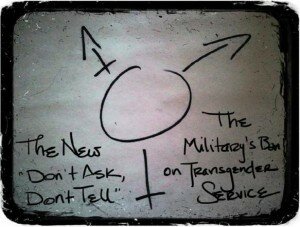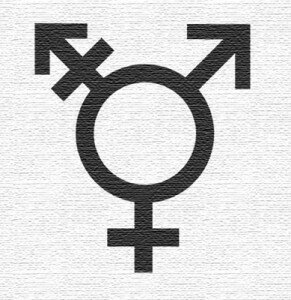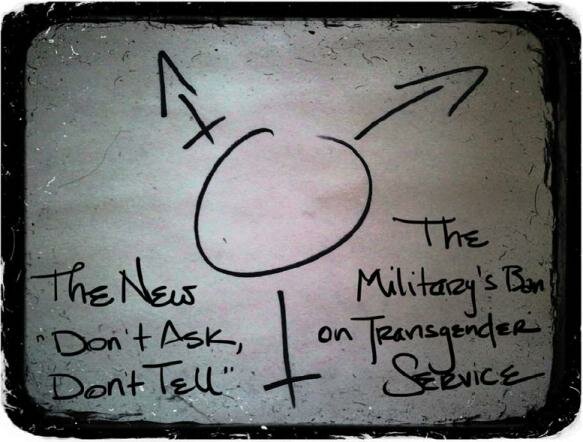The New DADT: The Military’s Ban on Transgender Service

OutServe interviews transgender service members, veterans, and political advocates
By Katie Miller, OutServe Board of Directors
 Though OutServe boasts an impressive 51 regional chapters, a handful of chapters remain hidden from the public eye. One of most underground of these chapters contains a modest 44 members. Like most chapters, they post videos, share website links, and engage in friendly banter. But they are different. Comprising just less than one percent of the network, they are OutServe’s transgender membership.
Though OutServe boasts an impressive 51 regional chapters, a handful of chapters remain hidden from the public eye. One of most underground of these chapters contains a modest 44 members. Like most chapters, they post videos, share website links, and engage in friendly banter. But they are different. Comprising just less than one percent of the network, they are OutServe’s transgender membership.
The repeal of “Don’t Ask, Don’t Tell” (DADT) means that gays and lesbians can serve openly in the military without fear of discharge.
However, the ban on transgender service remains intact. Gender Identity Disorder (GID) is considered a mental disorder by the American Psychological Association, and the military considers it a medically disqualifying condition. Not only are transgender individuals who wish to join the military prohibited from doing so, but those already serving honorably in the Armed Forces can be ousted if suspected to be transgender or found cross-dressing.
As the LGBT movement, both military and civilian, has zeroed in on the marriage and partner benefits issues, transgender service members still find themselves living under the “Don’t Ask, Don’t Tell” conditions many of us thought no longer existed. They struggle every day to pass as their biological sex and risk losing their careers if they are outed, despite the impressiveness of their service records.
This past month, I had the opportunity to hear from four transgender service members and two veterans affiliated with OutServe Trans. Three are transitioning from male to female (MTF), and three from female to male (FTM). They are serving in the Army, Navy, Marine Corps, and Army National Guard. Four are enlisted and two are officers and West Point graduates, a company commander and former Special Forces officer, respectively. Names have been changed in order to protect the identities of the interview participants. Pronouns refer to the sex the respondents identify with, not the biological sex. For example, someone transitioning from male to female is referred to by a female name and using the pronouns “she” and “her.”
Although I observed several commonalities across the testimonies, the experiences of those I interviewed cannot be lumped into a single narrative. I will certainly come up short in my effort to convey the complexity of their stories, but I hope that this article will at least disprove attempts to portray trans people as disturbed, ill and unfit for military service. The issue is dynamic and variant and cannot be reduced to a single narrative and certainly not a single policy.
For many of these service members, my interview was the first opportunity for them to share their experiences publicly. Their courage, honesty, and everlasting sense of duty to their country were nothing short of inspirational. I am honored to share some of their stories with the
OutServe Magazine readership.
Coming to Terms
Although most of the service members interviewed remember feeling as if there was something different about them from a young age, some did not begin identifying as transgender per se until later in their lives. Dave, an FTM active-duty Marine, recalled, “I was doing school shopping with my mom, and she said, ‘You have to start wearing a bra.’ And I was really upset about that. That meant that I couldn’t be a little boy anymore. I was becoming a woman.” When asked whether he identified as trans at that point, he responded, “At that age, I didn’t even know it was possible to have that.” Dave became aware of the existence of transgender people before enlisting in the military, but noted the unexplainable self-loathing he endured as his body feminized against his will until that point.
In contrast, Jessica had deemed herself transgender when browsing the Internet in middle school, which gave her a sense of comfort. “Just knowing that, what I was and that there were other people out there like me, made me able to focus on other parts of my life,” the MTF Marine veteran told OutServe.
Dan, who is actively serving in the Navy, came to terms with himself much later in life. “I’ve always kind of known, but I never had a word for it. I identified as a butch lesbian for a while, but even as a lesbian I looked uncomfortable, often slouching over to hide my chest.” Ironically, deployments helped Dan better understand himself.“ In Bahrain and Dubai, the men would often mistake me as male. And I didn’t feel the need to correct them. I loved being called ‘Sir.’ That’s when I knew.”
Still, others began identifying even later in life. Laura, an MTF Army officer, continued to struggle through her situation during West Point and long after. She felt, “I knew what I was, but still tried to cure myself. And the best way to hide or cure myself was to get married, and maybe time, love, or parenthood would make me better.” Accordingly, she married a woman, had children, and had a flourishing military career in the Special Forces, and later, the Medical Corps. It was not until her children were grown and she and her wife had grown apart that she could no longer deny her feelings.
Passing in the Military
Despite identifying as gay, lesbian, or transgender by the time they were of enlistment age, these service members joined the military for the same reasons as everyone else. Several had close family members who were in the military; those from small hometowns wanted to gain more worldly experiences, and some were simply looking for a challenge. However, it was readily apparent that every one of them had an intense desire to serve their country.
Once in the military, two of the MTF service members reported that they had “passed” with relative ease. Both Jessica and Amy—who is about to take command of an Army company—had adjusted well to military life, though they struggled at times. Jessica explained, “I just didn’t really think about it. Nobody ever knew or suspected. I was focused on training or my deployment and didn’t have time to think about [being transgender] until I laid down on my rack for the night. That was always the hardest. And seeing females walking around, doing their jobs, being Marines, that was a ‘trigger’ for me.” Similarly, Amy fell into a routine at West Point and passed as male without suspicion. But when in the presence of female cadets in civilian clothes, she became upset that she “just couldn’t look the same.”
The FTM service members I spoke to were able to pass without any concerted effort to act like their biological sex, but for different reasons. Dan pointed out, “I’m just seen as a lesbian, so they don’t say anything.” Because masculinity in women is more acceptable than expressed femininity in men in a military environment, Dan knew he had more liberty to express his gender identity than a trans woman might.
 Finding Community
Finding Community
While a cadet, Amy was able to reach out to a regional group for trans-women (MTF) in the area. Similarly, Jessica could find community with groups on the Internet. Unfortunately, the two noted that they were just not the same type of trans. The underlying anti-war sentiment of civilian trans groups served as a barrier for Jessica and Amy. In the military, they were forced to hide being trans; in the civilian world, they were often shamed of their affiliation with the military.
FTM service members experienced similar divide. At a lesbian bar off post, the owner told Dan he was not welcome. “She told me ‘you see yourself as a boy and this is an epidemic that is taking away our butch lesbian women.’” Although chuckling about the audacity in retrospect, “It was still hurtful.” To some, women transitioning to men represented a betrayal of the lesbian community.
But not all of the people I interviewed had wanted to find others like them. Laura made a deliberate effort to distance herself from cadets rumored to be gay or lesbian. “It scared me. I had to stay away.”
Amy eventually confided that she was MTF to the lesbians she met while at the academy, similar to many FTMs who were generally assumed to be lesbians.
Dan and David were actually able to find other trans-people in the military as well, though only one or two.
For many, joining the OutServe Trans chapter was the first time they had met other trans service members, especially FTM. (The demographics of the OutServe Trans group could indicate there are significantly more FTM than MTF military personnel.
David commented, “I would be in a lot worse shape than I am now without OutServe Trans. People actually understand what I’m talking about. It’s good to see other people out there doing well, and it lets other people know they can do it too.” OutServe Trans has been an opportunity to merge two identities mutually incompatible elsewhere.
Transitioning
The decision to begin transitioning—taking hormones and/or undergoing gender reassignment surgery—was largely affected by the biological sex of each of the interviewees. Those transitioning from male to female felt obligated to wait until leaving the service. Jessica noted that her upper body strength has decreased dramatically since starting hormones four months ago. If she had started estrogen while still a Marine, “the chances of not passing [as male] would have gone up” even though she is confident she could still meet the physical standards. About to take company command, Amy also commented, “I have to put my professional life first. If I’m going to lead soldiers, I have to be in the best physical shape possible. I could have started hormones if I wanted, but I don’t want to compromise my profession.”
For most transgender people, starting hormones requires going to a therapist who will confirm that an individual has Gender Identity Disorder and will authorize the prescription. Because a GID diagnosis automatically warrants a medical discharge, service members either pay to see a civilian therapist, unbeknown to the military, or begin taking hormones without the consent of a therapist.
For FTM service members, the latter is not uncommon. David began T-Bomb (a brand of testosterone) while deployed to Japan. After a tour in Afghanistan, where testosterone was inaccessible, he returned to the states and resumed the hormone. He started injections four months ago, and his transition has gone unnoticed in the Marine Corps.
Although he recognizes that FTMs are less likely to arouse suspicion, he must still proceed with caution. “My voice has gotten lower, hair is starting to grow, and I have to shave my upper lip sometimes. But I’m black, which means that once I start shaving every day I’ll get razor burn. Then someone has to say something.”
According to the Servicemembers Legal Defense Network, it should be noted that a service member does not have to begin physically transitioning to be deemed unfit for the military and discharged. The mere act of identifying as transgender, thereby possessing a disqualifying medical condition, justifies the separation. Bryan, an Army National Guardsman who has been involved in trans activism, explained, “To be trans, you don’t have to want surgery or to have had surgery. Plenty of people just identify outside the gender binary.” However, the GID disqualification does not make this distinction.
The Politics, the DSM, and the Potential for Progress
Several service members believe that GID must be removed from the Diagnostic and Statistical Manual of Mental Disorders before the military will consider lifting the ban on transgender service. Unlike DADT, the military is solely responsible for determining the medical and psychological barriers to service, so it would not take an act of Congress to repeal the ban. Bryan articulated, “I don’t think you can convince top brass without the American Psychological Association acting first. As long as being trans is considered a mental disorder, then it’s hard to believe they would go against that.”
Bryan also explained why removing GID from the DSM could cause controversy within the civilian transgender community; a GID diagnosis allows a trans person to have hormones paid for by health insurance. Without it, expenses would be out of pocket. “I can see why many people would be upset with that.”
Mara Keisling, the executive director for the National Center for Transgender Equality (NCTE), disagrees that the DSM must be the first step in repealing the ban. She points to the issuance of medical waivers for other mental disorders, such as anxiety and depression. “There is no reason why the military cannot use objective, rational criteria to determine if a trans person is fit to serve. The range of trans people is huge. Some people may have already transitioned entirely by the time they want to serve. Some people may identify as trans but have no desire to physically transition. But they’re still not allowed to serve because the disqualification is condition-based, not dependent upon the individual.”
Bryan also drew attention to several steps the military could take before repealing the ban entirely. For Bryan, wearing his biological sex-appropriate Class A’s presents a problem. Comprised of a skirt and pumps, the uniform is overtly feminine. “If we’re going to start breaking down gender boundaries, we can start small and begin with uniforms.” He also believes repeal of the combat exclusion policy, which prohibits women from serving in the infantry and other combat arms, would be a step in the right direction. Having served alongside many female Marines, David agreed. The concept of female weakness adversely affects both women who want to enter the combat arms and trans women who wish to remain in the military.
Keisling and Bryan also pointed to the progress several government agencies have made this past year in transgender equality, most notably the Department of Veterans Affairs. Due in large part to the work of Keisling and the NCTE, the VA now offers therapy and hormone treatment to trans veterans. The VA must also refer to a patient by his or her preferred name and gender pronouns, regardless if their birth certificates have been changed to reflect these changes. Keisling said, “the military is falling behind,” when it comes to their trans policies.
Much like “Don’t Ask, Don’t Tell,” the very people affected by the transgender exclusion policy are unable to speak out about it without getting discharged. The military and the American public are largely unaware that not only are trans people capable of serving in the military, but they are already doing so. Bryan and Keisling both saw the necessity of trans service members telling their stories in order to educate the public and change opinions.
Why Trans Service Matters
All the service members with whom I spoke were either considering or had already made the decision to leave the military. All of them cited their desire to transition as a major factor. Despite their honorable service and inspirational sense of duty, sacrificing their identities was an unsustainable pursuit.
Jessica confided, “Sometimes I get teary thinking about never being a Marine again. I want to be in for my entire career. I want to retire as a first sergeant or, hell, maybe even a sergeant major one day. I’m not done yet.”
—
Please contact KatieMiller@OutServe.org for media inquiries.






